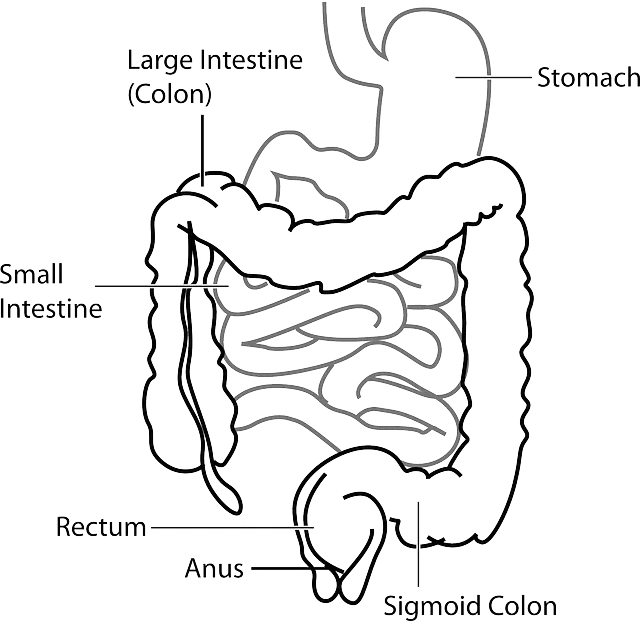Crohn’s Disease is one of the inflammatory bowel diseases (IBD). This means that there is inflammation affecting the tissues of the digestive tract. It can affect any section of the digestive system from the mouth to the anus.
Symptoms of Crohn’s Disease
Crohns can affect any part of the gastrointestinal tract, including the mouth, small intestine as well as the large intestine. It can cause various symptoms, including diarrhoea, pain and weight loss.
Nutrition and growth may be adversely affected due to the disease.

The main symptoms are:
- Loss of appetite
- Weight loss
- Feeling generally unwell
- Flatulence (lots of gas, or smelly gas)
- Abdominal pain and cramping
- Low grade fever (high temperature – or feeling chilly)
- Pain in the abdomen (tummy)
- Anaemia or low iron levels
- Diarrhoea
- Blood in stool (less common)
- Mouth ulcers

Who gets Crohn’s Disease?
- Mostly Crohns disease starts before 35 years of age, generally between the ages of 14 and 24 years, but it can begin at any age.
- It affects both men and women.
- About 20 percent of people with Crohn’s disease have a relative with IBD or other autoimmune conditions like rheumatoid arthritis.
- It is more common in people of Caucasian and Jewish decent.
Medical Diagnosis
- Colonoscopy – This allows viewing the entire colon using a thin, flexible, lighted tube with an attached camera. Small samples of tissue (biopsy) are taken for laboratory analysis, which may help confirm a diagnosis. In the majority of people with Crohn’s, the diagnosis is made after examining the tissue from a biopsy under the microscopy, along with information on the appearance and location of the lesions.
- Antibodies may be found against certain foods – we recommend a full assessment of likely contributors
- Stool analysis
- This is usually done to rule out potentially pathogenic bacteria and to measure the levels of a gut-specific inflammatory marker called calprotectin. Calprotectin can be used to monitor the level of inflammation in the intestines.
Various therapeutic options are available, including medical, surgical and nutritional options.
Management aims to control the inflammatory process, resolve symptoms and prevent complications.
In children and adolescents, ensuring normal growth and development are critical.
Medically, Crohns is considered a life-long condition without a cure. It tends to have periods of exacerbation and remission, which means that there are typically episodes of no symptoms, interrupted by the reappearance of symptoms.
Crohn’s Disease and the Gut Microbiota
Dysbiosis (alteration of the normal, healthy, gut microbial composition) has been linked to IBD, and has been found to be more common in Crohns, with lower microbial diversity (a marker of a healthy gut bacterial composition).
Specific bacteria associated with producing butyrate (a marker of healthy gut microbiome), such as Faecalibacterium prausnitzii are decreased and Escherichia coli – associated with production of endotoxins and histamine – is increased in Crohns’
In patients known to have IBD, a genetic component is suspected to increase their susceptibility to specific gut microbes. These can trigger arthritis. Hence a Crohn’s patient who has diarrhoea and arthritis may have either a “reactive arthritis” caused by a gut infection, or it could be a flare of the IBD associated with arthritis.
Faecal Microbial Transplant (FMT)
Faecal Microbial Transplant (FMT), which is also known as stool transplant or bacteriotherapy, is a procedure in which faecal matter, or stool, is collected from a healthy person and administered into the intestines of another person. Interestingly, transfering donor faeces by way of “yellow soup” to a recipient with gut diseases dates back to the 4th century in China!
In FMT, the donor stool is given either by mouth (though a tube into the intestine, or in “Crapsules”) or via the rectum (enema) or during colonoscopy.
Preliminary studies suggest that FMT may be an effective therapy in Crohn’s disease, but so far, this is not widely available as a treatment.
Complications
- Arthritis (swollen joints, such as knees, ankles, elbows, hips, and wrists) and arthralgias (joint aching without inflammation) can affect up to 40% of people with IBD. Pain is often worse when there are flares of Crohns symptoms.
- Abcesses may occur if the damage to the intestines is severe, and an infecton sets in.
- Fistulas (a crack in the tissue) may form in the area around the anus. These occur when damage extends through the layers lining the colon and can extend into other organs such as the bladder, vagina and to the skin.
Nutritional Impact of Crohn’s Disease in Children
Almost all children with Crohn’s have a history of weight loss or lower-than expected weight gain. This is typically due to decreased intake, due to the anorexic effects the disease process, plus pain and feeling full after a small amount of food.
Other contributory factors include malabsorption or increased energy requirement. Children often exhibit poor growth and delayed onset of puberty. This can mean that a child might not reach their full height potential.
A nutritional approach to the management of Crohn’s Disease has been supported by recent research, with the benefit of controlling inflammation, reducing symptoms and optimising growth. A great advantage is the minimal side-effects and permitting avoidance of other therapies that may adversely impact on children with regards to growth, development and socialisation.
How We Might Support You
- A comprehensive case history, including gathering details about your usual diet, medical history, laboratory and specialist reports, imaging studies, endoscopy information, medication use, etc., is the starting point.
- Given the expanding body of research linking the gut microbiota to IBD, a stool microbiome test is recommended. You may order this in advance to have the results available at your first appointment.
- After testing for Coeliac disease, you might be recommended to have a trial off wheat and dairy.
- Many people with Crohn’s are found to have food allergies, the most common being soy, eggs, fish, shellfish, nuts, peanuts, as well as wheat and dairy products, which has been demonstrated in some studies. Some people may choose to conduct IgG4 (+/- IgE) food antigen testing.
- Testing for environmental allergies, which may be present in almost 2/3 of people with the condition. Allergies to pollen and moulds are common and may play a role in flares of the condition as the seasons change.
- High potency multivitamins may correct nutritional deficiencies if present.
- Omega-3 is an type of essential fat- some componentns may help with decreasing the inflammatory response.
- Probiotics. Some specific strains may be indicated. Your practitioner may make recommendations based on the results of your stool microbiome test.
- Individualised herbal medicine and/or nutritional supplements may be prescribed to support your intestinal lining.
- Supplemental butyrate may be prescribed. Butyrate is a very important product of a healthy gut microbiome, which serves as a key modulator of the gut inflammatory response.
- Recommendations may include altering when, as well as what you eat. Increasing calorie intake if weight loss has been a problem for you, or less food frequent food intake may allow healing time if the small intestine is affected.
References & Resources
- Crohn Disease. MSD Manual, Professional (2022)
- Ectopic gut colonization: a metagenomic study of the oral and gut microbiome in Crohn’s disease. BMC Gut Pathogens 13 (2021)
- A microbial signature for Crohn’s disease. Gut 2017;66:813-822
- Treating IBD by rebalancing the gut microbiome. IBDVisible, 2021;Aug 9
- Increased prevalence of environmental allergy in patients with Crohn’s disease J Allergy Clin Immunol. 2004 Feb; 112 92), S276
- Food intolerance and Crohn’s disease. Gut 1993; 34: 783-787
- Non-pulmonary allergic diseases and inflammatory bowel disease: A qualitative review. World J Gastroenterol. 2014 Aug 28; 20(32): 11023–11032.
- Increased incidence of allergic disorders and elevated food-specific serum IgG4 levels in Japanese patients with Crohn’s disease. Allergology International (1999) 48: 247–251











